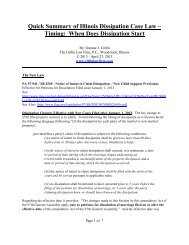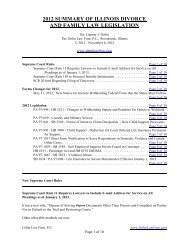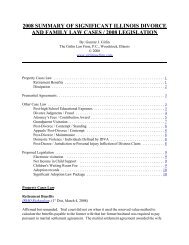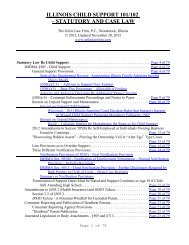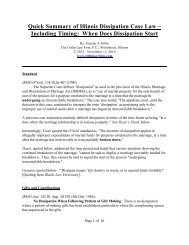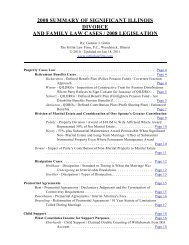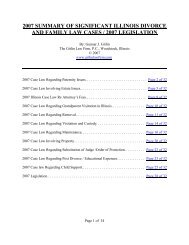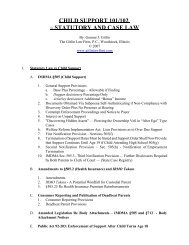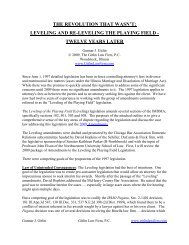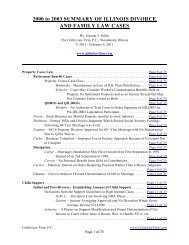Gitlin Law Firm 2010 Illinois Divorce and Paternity Case and ...
Gitlin Law Firm 2010 Illinois Divorce and Paternity Case and ...
Gitlin Law Firm 2010 Illinois Divorce and Paternity Case and ...
Create successful ePaper yourself
Turn your PDF publications into a flip-book with our unique Google optimized e-Paper software.
Property <strong>Case</strong>s <strong>Law</strong>:<br />
Retirement Benefit <strong>Case</strong>s<br />
Defined Contribution Plans<br />
Schinelli – Defined Contribution Plan <strong>and</strong> Change in Value of Plan from Date of <strong>Divorce</strong> Trial<br />
to Date of Distribution<br />
nd<br />
IRMO Schinelli, (2 Dist., January 12, 2011).<br />
This was the second appeal. In the first appeal the court had, among other things, changed the cap<br />
regarding the percentage order regarding maintenance downward from $650,000 so that the ex-wife<br />
was sharing in the her former husb<strong>and</strong>'s income regarding supplemental maintenance only for<br />
income between $200,000 to $250,000 – rather than $200,000 to $650,000. Schinilli I, was<br />
unpublished.<br />
This case is important because in a number of divorce cases the court enters its judgment dividing<br />
assets based upon evidence at the time of trial. But by the time the court decides the case after<br />
taking the case under advisement, etc., <strong>and</strong> the assets are divided, the assets awarded to one party<br />
may be of significantly less (or different) value than per the previous evidence. This might be<br />
remedied by a stipulation regarding changes in value. But of course, after the close of proofs it may<br />
be difficult or impossible to present this evidence. In any event, the changes in value in this case<br />
were even more profound because the delay was attributable to the appeals.<br />
In this case, the ex-husb<strong>and</strong> pointed out that the value of his 401(k) plan on rem<strong>and</strong> had dropped<br />
drastically due to market conditions – with the evidence at the time of the trial -- in March 2007 --<br />
indicating the value had been $309,423. The trial court stated:<br />
The evidence established that as of March 31, 2009, the Wachovia 401(k) account<br />
had a value of $179,830. In response to comments by the parties as to its intent in<br />
dividing the retirement accounts, the trial court explained: “I added them all up,<br />
divided them by two. She kept hers, he kept his; except for the 401K for him, he<br />
would have to roll over money into her. So that, when they all ended up at the<br />
bottom, they had the same amount. The Wachovia 401K was the vehicle designated<br />
to be the one that money would come out of his so that, when it went into hers, they<br />
would each have the same total for all of their accounts.<br />
The ex-wife's attorney had argued that the divorce judgment provided that she was to receive<br />
$152,522 from the Wachovia 401(k). So that is the amount she should receive. At the close of the<br />
hearing on rem<strong>and</strong>, the trial court awarded the wife $152,522 (84.8%) of the Wachovia 401(k)<br />
account’s value. The ex-husb<strong>and</strong> contended that the trial court’s dissolution order intended that the<br />
parties’ retirement assets be divided equally between them. But the effect of the QDRO was to<br />
award his ex-wife an additional $125,000.<br />
In an interesting wrinkle the appellate court stated:<br />
<strong>Gitlin</strong> <strong>Law</strong> <strong>Firm</strong>, P.C.<br />
Page 4 of 49<br />
www.<strong>Gitlin</strong><strong>Law</strong><strong>Firm</strong>.com




